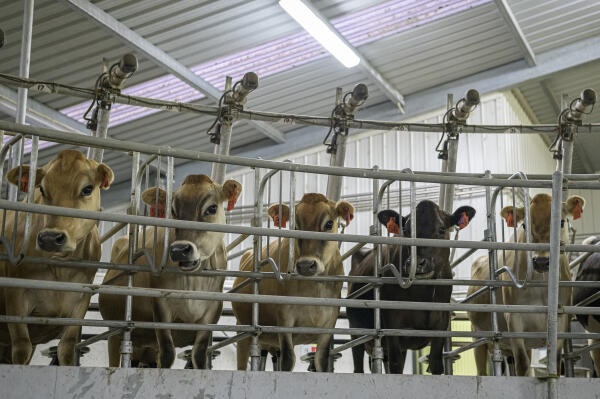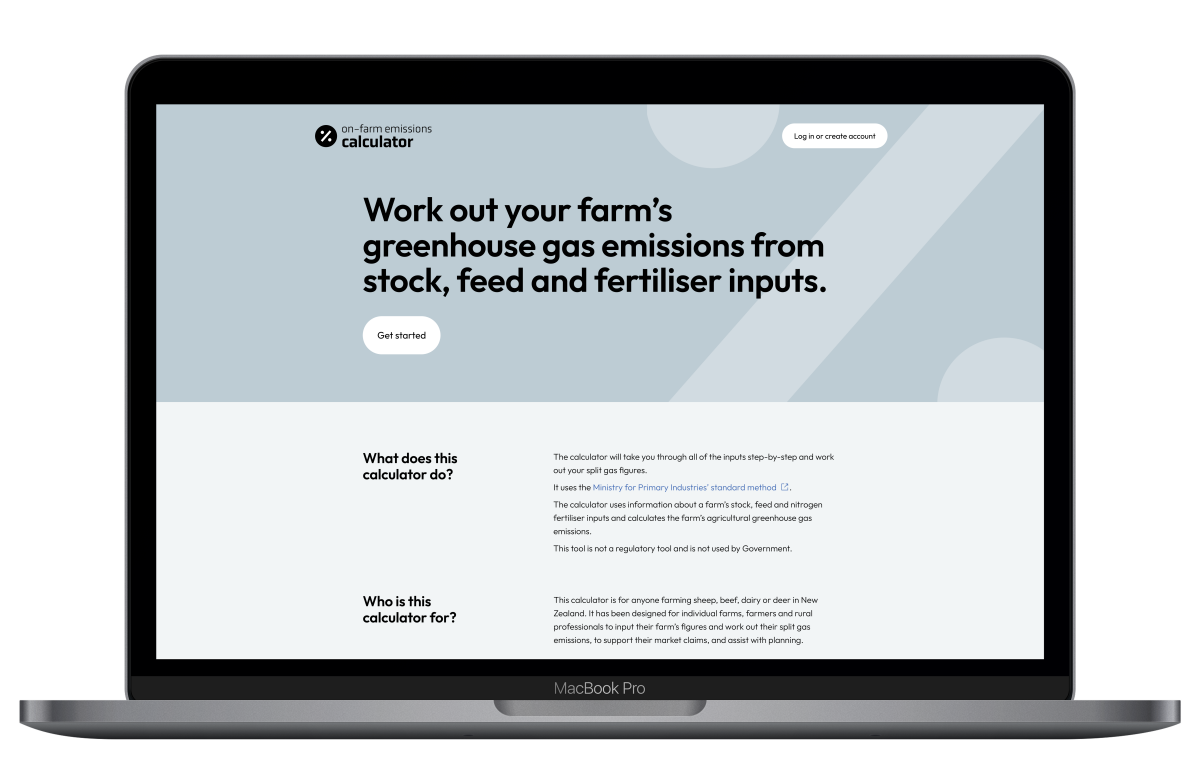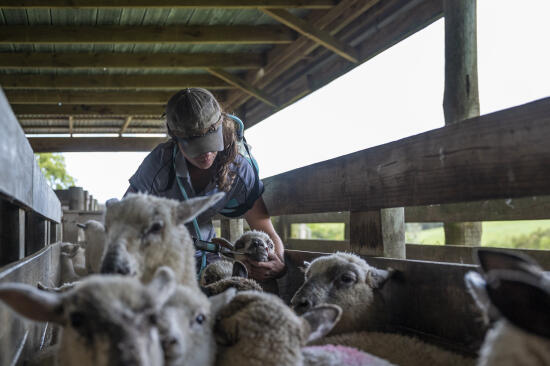Knowing what your farm’s greenhouse gas emissions are and where they come from is the first step towards reducing them.
Why you need to know your farm’s greenhouse gas numbers

Your greenhouse gas “numbers” are the biogenic methane and nitrous oxide emissions coming from your farm from livestock production and nitrogen fertiliser use.
Global demand for sustainable practices is driving New Zealand’s exporters—meaning farmers and growers are being increasingly asked to monitor, report, and reduce their GHG emissions. Global markets are incentivising customers with lower emissions through price premiums. Similarly, financial institutions are incentivising loans aligned with emission reductions (and other environmental targets) through lowered interest rates.
Knowing your numbers tells you what your current agricultural greenhouse gas emissions are and will help you plan the most effective way to manage those emissions.
Calculating your greenhouse gas number
There are several different ways that you can find out your farm's greenhouse gas numbers:
- Use a tool or calculator to do it yourself
- Ask your farm advisor which tool/s they use and what services they can offer you in this area
- Ask your processing company or industry organisation for advice. Some are moving into this area, including providing these numbers for their farmers
Tools and calculators
A variety of different tools and calculators for estimating agricultural greenhouse gas emissions at the farm level are available. These range in complexity and cost from simple, quick and freely available calculators to more detailed quantitative tools that might also require assistance from a farm advisor in order to access and/or interpret the results. Some of these tools are also specific to a particular farm type.
How are emissions calculated
Direct measurement of greenhouse gas emissions from your farm is not practical. Instead, calculators work out an emissions estimate for your farm based on mathematical models. Some calculators use estimation methods that are simple, for example, a fixed emission per animal per year – or more complex, using models that require farm specific data on diet quality, animal size and animal performance.
Different methods mean calculators can give you slightly different (but valid) results. However, using different methods makes it hard to compare emissions consistently across the country and a standardized methodology for New Zealand is needed.
Moving toward a standardised approach to calculating emissions
The Ministry for Primary Industries (MPI) has developed and made freely available a standardised, science-based methodology for measuring farm-level greenhouse gas emissions.
“New Zealand Farm Emissions Method A farm-level approach for estimating biogenic emissions” on the MPI website.
The new, standardised methodology aims to ensure consistent and comparable emissions estimates across different farms and calculators, providing greater transparency in how emissions are calculated, and making it easier for farmers and regulators to understand the results.
It is expected that existing calculators will adopt this methodology and embed it within existing tools. This will help New Zealand move towards standardising how we estimate on-farm emissions across the country and key to addressing our market's desire for transparent emissions reporting and, potentially, to pricing emissions in the future.
The on-farm emissions calculator – a free tool to estimate on-farm emissions
The standardised method sits behind a free calculator developed by AgResearch (now part of the Bioeconomy Science Institute):
Try out the On-Farm Emissions Calculator here.
As with other calculators, the On-Farm Emissions Calculator estimates emissions from livestock and fertiliser and presents these outputs on a ‘split-gas’ basis – Methane and Nitrous Oxide. In the future the MPI model will be updated to capture mitigation actions taken on-farm. It is likely that these will include improvements to effluent management, low methane genetics and feed additives in the next release. This will allow users to test and learn how mitigation actions affect your farm system – without any data being stored.
The On-Farm Emissions Calculator is primarily aimed at farmers without processor obligations or access to paid tools who want to understand their farm's emissions for planning purposes. It makes available a standardised, government-endorsed method for calculating on-farm emissions.

See the links to the how to use videos below:
Tools that are available for calculating emissions
The most important thing is to use the same tool to track your emissions over time. This helps you link your farm management decisions to your greenhouse gas emissions, making it easier to understand how your system affects—and can reduce—its environmental impact.
The on-farm emissions calculating tools that are available in New Zealand are:
-
On-Farm Emissions Calculator, a government-backed, free calculator, based on the MPI standardised method, to estimate emissions from stock, feed and fertiliser, you can find the calculator here.
Farm management software
-
OverseerFM is a software platform for modelling nutrient flows through a farm and includes a greenhouse gas component. Visit the Overseer website here.
-
Farmax is a software platform for modelling farm system productivity and profitability and includes a greenhouse gas component. Visit the Farmax website here.
Industry specific tools
-
Beef + Lamb New Zealand has developed a 'GHG Calculator' - a free online tool for farmers to measure and report on-farm greenhouse gas emissions and sequestration, reflecting the individual farm's livestock and production systems: Visit the GHG Calculator on the Beef + Lamb website.
-
'PigGas' is a model developed by the pork industry to estimate emissions from piggeries. Visit the NZ Pork website to find out more.
-
Horticulture New Zealand has a nitrous oxide emissions spreadsheet developed by (and available from) MPI for its growers. You can download the spreadsheet from the HortNZ website.
Greenhouse gas tools
-
'MyImprint Farm' is a proprietary model based on the New Zealand Greenhouse Gas Inventory. It can model farms that have sheep, beef, deer and dairy cattle and includes forestry. Visit the 'MyImprint Farm' model on their website.
-
The Ministry for the Environment (MfE) has a spreadsheet calculator for New Zealand businesses, including farms, to work out their emissions. You can download the spreadsheet from the MfE website.
-
Alltech has a proprietary carbon footprint service ‘E-CO2’for businesses. Find out more on the Alltech website.
-
Grazing Systems Limited operates the ‘Enviro-Economic Model’ (E2M) that is based on a linear-programming platform and can model whole farm systems including greenhouse gas emissions.
-
Toitū Envirocare offers a tool that builds on greenhouse gas data from OverseerFM to provide an ISO-certifiable carbon footprint of a farm. Visit the tool on the Toitū website.
-
Some processors use third party tools such as The Bioeconomy Science Institute’s AgLCA: Life Cycle Assessment and make the results available to suppliers. Visit the AgResearch website to find out about AgLCA.
What information do you need?
 At a basic level, annually, you will need to know:
At a basic level, annually, you will need to know:
-
Livestock numbers by stock type/s, either using monthly values or (for simple tools) a weighted annual average
-
Amount and type of synthetic nitrogen fertiliser applied
Additional data that can support a more detailed estimation of greenhouse gas numbers includes:
-
Farm size - total and effective areas
-
Livestock class, age, number and movements
-
Production data such as total kg milk solids, liveweight or crop yield, and percentage share of revenue
-
Purchased feed
-
Nitrogen fertiliser or lime applications, including product type, rate and timing

